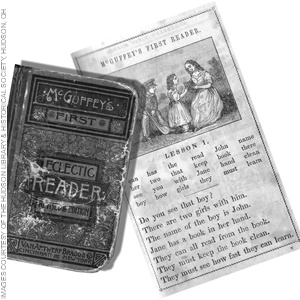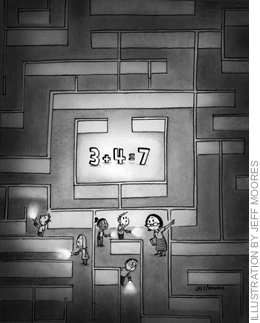
Tough Love at the Hyde Schools
Shortly after his initial visit, I asked James Traub whether he planned to evaluate Hyde according to how effectively we honor our mission or on the basis of how closely we embody his perception of the good school. Reflecting the latter, Traub’s “The Moral Imperative” (Features, Winter 2005) is a thoughtful piece on a complex subject. I write to fill in a few gaps.
His education worldview focused tightly through the window of the classroom, Traub naturally begins with a classroom drama. Although his depiction of the scene might be familiar to Hyde students and faculty, the accompanying illustration is so incongruous to their experience that they have uniformly wondered if the drawing was intended to apply to another article in the magazine. (For one thing, any Hyde student would tell the kid in the front, “No hats in the building!”)
In examining the Hyde “ship,” Traub’s bias (that is, school = classroom) prevented him from setting foot into its powerful engine room: the Hyde Family Education Program. Hyde’s 40-year trial-and-error quest to discover the best way to develop character has led us to our most significant discovery: good teaching will invariably lose out to poor parenting. The dynamics within our families can either catapult us to personal greatness or chain us to desperate dysfunction. Traub’s decision to disregard Hyde’s family education program prevented him from seeing what makes the place tick.
While Hyde’s holistic balance of academics, character, and family is undoubtedly at odds with Mr. Traub’s preferences, Traub misleads the reader when he suggests that Hyde has abandoned academic requirements for graduation. Our enterprising culture did indeed lead us to a brief flirtation with this notion in our earliest days. However, stringent traditional requirements have been in place for more than 30 years.
I must strenuously object to at least two examples of the writer’s tendency toward broad-brush characterizations. His depiction of the members of the Hyde community as “wounded souls” is both inaccurate and unfair. Character development is good for both wounded souls and confident ones. Both can be found at Hyde. He also goes way over the line in claiming that the “Hyde content” has been drained out of Hyde-New Haven. Suffice it to say that Mr. Traub neither visited the school nor spoke with anyone who works there.
The mathematician would categorize as “necessary but not sufficient” his reference to Hyde as a family “caste.” To be sure, the Gauld family has long had a heavy hand in the leadership of Hyde. However, Mr. Traub fails to mention that three of Hyde’s four schools are led by individuals with no familial ties to the Gaulds. There are no family members on Hyde’s board of governors, the authority to which all four of those teams report.
Pointing to our 100 percent college acceptance rate at Hyde-DC (all four schools combined annually attain 98 percent), Traub seems begrudging when he offers that we “must be doing something right.” We offer him a standing invitation to take a hard look at our “engine room” should he want to discover the nature of that something.
Malcolm Gauld
President, Hyde Schools
Chicago’s Proven Results
Regarding your two stories about Chicago’s ending of social promotion (“Retaining Retention” and “Teachers and Students Speak,” Features, Winter 2005), it should be noted that one of the most important policy decisions that Chicago mayor Richard M. Daley made when he took control of the public schools in 1995 was to end social promotions.
Before then, the high school dropout rate was almost 16 percent; the percentage of our elementary students meeting national norms on the Iowa Test of Basic Skills in reading was less than 37; the percentage of our students testing in the bottom quarter was about 32. But things have changed. By 2003 the dropout rate had fallen to 13 percent, the percentage of students meeting national norms was up to 41, and the percentage of students testing in the bottom quartile was down to about 24-better than the nation as a whole. This is all to say that we see retention as a tool to help students get the help they need. And it works.
Your articles note many of these facts, but it must be pointed out that the key to making retention effective is to recognize it as a warning sign and fix the problem. This year, we have refined our policy to require that a personalized learning plan be designed for each student retained, so that the principal, teacher, and parents can all monitor the child’s progress.
These students also work with specially trained teachers. And previously retained 4th and 7th graders now have access to extra learning opportunities after school and during the summer to make sure they stay on track.
We also are working to prevent retentions before they even occur, by targeting high-retention schools and implementing an intensive literacy program in the early grades. We already have more than 30,000 preschool slots systemwide and have expanded this program into full-day kindergarten in targeted schools.
We look forward to a day when no children are retained, not because they are simply passed along without scrutiny, but because they have mastered the skills and concepts needed for their grade level. On that day, we will know that we truly have served every child in every school.
Arne Duncan
Chief Executive Officer
Chicago Public Schools
Teaching Teachers
However flawed David Steiner’s study of the syllabi and texts used in three clusters of teacher education courses (foundational studies, reading, and methods of teaching), we agree with his basic argument that future teachers need more exposure to the three millennia of writings about schooling and education (“Skewed Perspective: What We Know about Teacher Preparation at Elite Education Schools,” Features, Winter 2005).
Unfortunately, given the current realities of mandated courses and prescribed curricula, this is impossible to achieve. For more than 30 years the American Association of Colleges for Teacher Education (AACTE) has pleaded for more “life space” for teacher education in the college curriculum, including five-year and fifth-year teacher education programs. Confined to the undergraduate curriculum, teacher education has surrendered space-once occupied by foundational studies-to courses in the technical aspects of teaching and learning and to more clinical practice.
Steiner faults courses in teacher education for what he perceives as ideological bias-specifically, for their contemporary and Western orientation. Given the minimalist curriculum assigned by the state, however, the wonder is that the syllabi have as much as they do. Faculty members do have choices to make, but the conversations at the AACTE are about “dispositional knowledge” and how to engage prospective teachers in the debates about liberalism and education.
Steiner insists that he wants teachers who are liberally educated, but his rush to judgment may produce the opposite effect: the state’s imposing an even more prescribed curriculum. Steiner is playing to the “new right monopoly” in education and setting the conditions that could lead to mandates for a sterile, neutral, and value-free preparation of teachers. Nothing could be more damaging to the (classical) liberalism that Steiner and AACTE are seeking.
David Imig
President and CEO
AACTE
In “Skewed Perspective,” David Steiner makes a valid claim about the ideology of American education schools, but he misreads its significance.
As the syllabi for teacher education courses suggest, there is indeed an ideological consensus around pedagogical progressivism in education schools, but it has had little serious impact on teaching and learning in American schools. It was that other branch of education progressivism, the administrative progressives, who shaped the form and function of American schools in the 20th century. Following the credo of social efficiency rather than inquiry learning, they created the modern education bureaucracy and a radically differentiated curriculum, complete with vocational rationale, dumbed-down courses, and a focus on life adjustment more than academic learning.
Research from inside and outside the ed school consistently shows that teacher education is an extraordinarily weak intervention in the process of socializing teachers, whose main influences are a long apprenticeship of observation as K-12 students before entering teacher education and the powerful culture of the school in which they begin to teach.
As for education professors, our primary accomplishment as acolytes of pedagogical progressivism has been to change the rhetoric of educators, who have all come to talk like constructivists. But beyond this talk-and a few formalistic changes, like placing desks in clusters instead of rows-there is little sign that the traditional teacher-centered mode of instruction has changed significantly in the past one hundred years.
Yes, education schools are ideologically convergent in ways that are intellectually unhealthy. But instead of beating the dead horse of education school ideology, researchers might better spend their time trying to figure out which forms of teacher preparation best enhance student learning.
David F. Labaree
Professor, School of Education
Stanford University
David Steiner replies:
Regarding David Imig: The point of my research was not that foundations courses are missing, but that their content is generally shallow and ideologically slanted. Teacher preparation programs unquestionably face time pressure, but Imig makes the unwarranted inference that more course work would produce better-balanced reading lists. This contradicts common sense: surely, to do more of what is being done poorly is not a winning proposition. The case for devoting more time to teacher preparation can only be made if we are ready to correct the deficiencies in teacher preparation that my study reveals. As for Imig’s opening rhetorical gesture, my research analyzes 165 syllabi-45 in foundations-from a representative sample of elite schools. Imig does not claim, or even suggest, that a larger sample would bring different results. Rather, in his eagerness to belittle my findings, he shows a defensiveness that raises concerns about the capacity of teacher education to reform itself.
Professor Labaree doesn’t dispute my methodology or my findings, but questions their significance on the grounds that teacher preparation is inconsequential. This would seem to argue for abandoning teacher preparation; yet Labaree calls for further research, implying that if we knew how to prepare teachers, then teacher preparation would have an impact. However, in claiming that meaningful preparation is yet to be found, he not only sidesteps my argument that teachers should be taught to think through intellectual and moral issues related to pedagogy, but also a long history of reflection on the aims, methods, and content of education. Moreover, if teacher preparation is to remain in business in the hope that it becomes consequential, then it surely matters that this preparation ceases to be ideologically biased.
Reading, Writing, and Willpower
I liked Diane Ravitch’s review of Paul Zoch’s Doomed to Fail (Winter 2005), which I also read with great interest. The myopia that overlooks student effort is, in my view, the biggest flaw in our current approach to education reform. Teachers, and teachers of teachers, tend to focus on what teachers do, not on what students do.
This reminds me of a story I heard Al Shanker [longtime president of the American Federation of Teachers] tell a couple of times:
Apparently, when Jaime Escalante moved to Sacramento, the local media were anxious to find out how good this famous teacher was. They found a 9th-grade student who said he was a lousy teacher.
Fascinated, they asked her why. She said she had had a problem with her algebra and went to Mr. Escalante for help. He kept her after school for several days and also on Saturday.
The media asked her what happened.
“Well,” she said, “I finally got it, but he didn’t teach me anything. All he did was make me work!”
Will Fitzhugh
Founder, The Concord Review
What’s a Teacher Worth?
In “The Uniform Salary Schedule” (Forum, Winter 2005), Brad Jupp cites Public Agenda research and identifies us as a “pro-teacher group.” While I believe most of us at Public Agenda admire teachers, Public Agenda is a nonpartisan, nonadvocacy research organization, and we don’t endorse a particular strategy for any group.
Mr. Jupp cites Public Agenda’s report on American public school teachers, our 2004 study “Stand by Me: What Teachers Really Think about Unions, Merit Pay, and Other Professional Matters.” In this study we found fairly broad support among teachers for some forms of differential pay-just not the form that ties pay directly to student test scores. But the research also suggests, at least among teachers nationally, that differential pay is just not an especially strong motivator or a top priority for most teachers. Beyond that, our surveys of superintendents and principals have shown strong support for reform of both salary and tenure.
Ruth A. Wooden
President
Public Agenda






